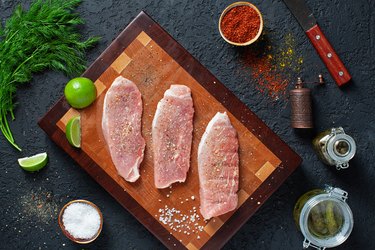
Thinking about cooking your pork loin in a convection oven? Compare with the alternatives. High-temperature roasting produces lots of browning, which means lots of flavor, but it tends to toughen and dry out your roast. Low-temperature roasting keeps the meat tender, but produces little flavor.
Cooking your pork tenderloin in a convection oven provides a middle ground — the dry cooking conditions brown the outside of your meat quickly, while maintaining the moisture inside your pork loin.
Video of the Day
Video of the Day
Read more: How to Cook Pork Ribs on a Propane Grill
Step 1: Trim the Fat
Trim the fat cap on your pork loin with a sharp knife, reducing it to a very thin layer over the surface of the meat.
Score it into a crosshatch or diamond pattern with shallow strokes of the knife, taking care not to cut into the meat itself. This helps the fat render out, leaving just a thin, brown crust at the end of the cooking time.
Step 2: Preheat and Season
Set your oven to convection mode, and position a rack in the top third of the oven. Preheat it to 350 degrees Fahrenheit.
Season your loin roast to taste, and place it on the rack of your roasting pan. The rack keeps your roast above its drippings, so it won't absorb fat from the bottom of the pan as it cooks.
Roast the loin at 350 degrees Fahrenheit for approximately 15 minutes per pound, until it's well-browned at the surface and an instant-read thermometer inserted into the middle of the roast reads 145 degrees Fahrenheit.
This is the minimum safe internal temperature for consumption of pork, according to the USDA Food Safety and Inspection Service.
Step 3: Rest and Serve
Remove your loin from the oven and let it rest under a loose covering of aluminum foil for five minutes before serving.
Read more: How to Make Oven-Baked Boneless Pork Chops
Make It Healthier
Be advised that many seasonings are high in sodium. The American Heart Association recommends limiting daily sodium intake to less than 2,300 milligrams per day. If you have high blood pressure, or other risk factors for heart disease, this recommendation drops to 1,500 milligrams.
While pork loin isn't one of the fattier meats, trimming excess fat still improves its nutritional value. According to the USDA, 3 ounces of untrimmed pork loin contain 7.5 grams of fat, while the same serving of trimmed pork loin has 5.3 grams of fat.
Pork loin is an excellent source of protein, packing 22.5 grams per 3-ounce serving. According to the National Academies of Sciences, males need 56 grams of protein per day while females need 46 grams. One serving of pork loin provides 40 to 49 percent of your daily requirements.
Things You'll Need
Sharp knife
Seasonings
Roasting pan with rack
Instant-read thermometer
Aluminum foil
Tip
The convection oven speeds cooking by using a fan to blow hot air across the roast. This dries the surface rapidly by evaporation, enabling the roast to begin browning much sooner and more thoroughly than it would in a conventional oven.
- USDA Food Safety and Inspection Service: "Safe Minimum Internal Temperature Chart"
- American Heart Association: "How Much Sodium Should I Eat Per Day?"
- USDA FoodData Central: "Pork, Fresh, Loin, Top Loin (Roasts), Boneless, Separable Lean and Fat, Cooked, Roasted"
- USDA FoodData Central: "Pork, Fresh, Loin, Top Loin (Roasts), Boneless, Separable Lean Only, Cooked, Roasted"
- National Academies of Sciences: "Macronutrients"